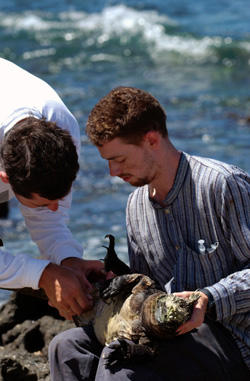
The Galápagos Islands present an extraordinary opportunity to examine patterns of migration and diversification of organisms. The geology of the islands is well understood and allows the timing and order of species colonization patterns to be inferred. In addition, islands differ in many ways, including size, habitat, and community composition, and this provides a backdrop for examining how different environments contribute to adaptation of various traits in radiating species. In this project, we plan to build on our existing knowledge of marine iguana evolutionary history by overlaying phylogeographic patterns of Hepatozoon parasites, and their potential arthropod vectors (mosquitoes, ticks). By examining the genetic patterns of host (marine iguanas), vector, and parasite, we can derive a greater understanding of how parasites disperse between populations. We use genetic techniques to collect data on parasite prevalence from all the major islands in order to determine how the ecology of each island contributes to the level of parasitism observed. For example, marine iguana populations differ in density, possibly due to local variation in levels of marine productivity. Population density could be one factor which impacts the ability of vectors to transmit parasites. In addition, the proximity of islands can also influence the ability of the host or vector to moved parasites between islands. This project is being developed in conjunction with Scott Glaberman (University of South Alabama) as well as from Leeds University, Acadia University, and the Galápagos National Park.

